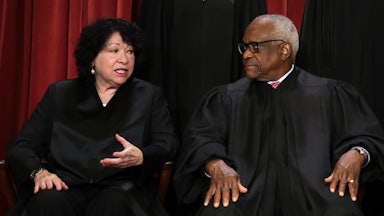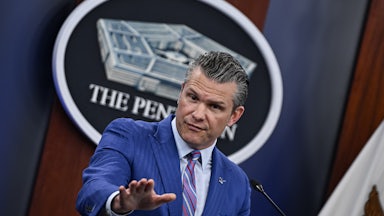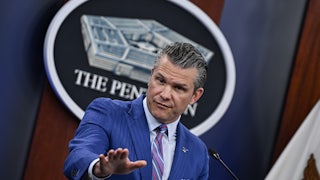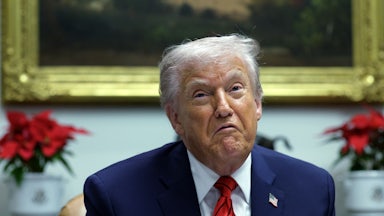A federal district court judge in Texas released one of the strangest dissents in recent legal history on Wednesday, effectively accusing one of his colleagues of judicial misconduct and making a series of personal attacks on legal groups and political figures over the state’s gerrymandering wars.
“The main winners from Judge Brown’s opinion are George Soros and Gavin Newsom,” Judge Jerry Smith, a Reagan appointee who has served on the court since 1987, wrote. “The obvious losers are the People of Texas and the Rule of Law. I dissent.”
Smith’s broadside runs 104 pages in length. That isn’t always unusual in gerrymandering cases, where lower court judges have to discuss each legislative map change in careful detail. But a significant portion of his opinion is not actual legal analysis or reasoning. Instead, it can only be described as a series of personal invectives aimed at the majority opinion’s author—and, weirdly enough, some of the litigants.
A small sample: Smith described Brown’s opinion as a “prime candidate” for a “Nobel Prize for Fiction,” as well as “the most blatant exercise of judicial activism that I have ever seen.” Brown is also accused of, in Smith’s words, “pernicious judicial misbehavior,” of serving as a “legislator/activist jurist,” and of being an “unskilled magician” in manipulating the law and precedent.
The dissent is, by its nature, not binding on any other court, and any persuasive weight it might carry is ruined by its caustic nature. Nonetheless, Smith’s unjudicial tone is a new marker for the decline in American institutions in the Trump era, as well as a startling insight into how at least some federal judges view the world around them.
The case arises from the ongoing nationwide standoff between Democrats and Republicans over redistricting and the 2026 midterms. Democrats are generally favored to pick up seats in the House of Representatives next fall, where the GOP currently holds a slim three-seat majority. Earlier this year, President Donald Trump pressured Texas Republicans to redraw their state’s congressional maps to be even more advantageous to them by eliminating five safe Democratic seats.
The Constitution requires states to redraw maps after each census every 10 years, but there is no explicit prohibition on doing it more often than that. Texas Republicans initially demurred since gerrymandering isn’t without risks past a certain point. By moving too many Democratic voters into formerly safe GOP districts to maximize partisan gain, Republican lawmakers could ultimately be more vulnerable across the board in a wave election. (Perhaps not coincidentally, a number of GOP-led states have opted out of this mid-decade redistricting scheme since Democrats dominated the elections held earlier this month.)
Texas leaders changed course after the Justice Department’s Civil Rights Division sent a formal letter to the state alleging that four congressional districts in Texas were unconstitutional because they were intentionally drawn as majority-minority districts. Though those districts were drawn in part to comply with the Voting Rights Act of 1965, the Trump Justice Department’s position is, in a nutshell, that forcing states to remedy racial gerrymandering is itself unconstitutional racial gerrymandering.
In response, Governor Greg Abbott called a special legislative session in July and state lawmakers ultimately redrew the map in August. A group of voters led by the League of United Latin American Citizens, or LULAC, filed a lawsuit soon thereafter to challenge the new map as an unconstitutional racial gerrymander for eliminating majority-minority districts. The Supreme Court is set to decide a similar question later this term in Louisiana v. Callais.
Absent that possible ruling, however, racial gerrymandering remains unconstitutional under the VRA, more than 60 years of Supreme Court precedents, and the Fourteenth and Fifteenth Amendments. That made it fairly easy for two judges on a three-judge district court panel to conclude that Texas had acted improperly by eliminating the majority-minority districts. Judge Jeffrey Brown, writing for the panel, granted a preliminary injunction and ordered the state to use its 2021 congressional map instead.
“The purpose behind the 2025 redistricting was to ‘take the people who were in those coalition districts’—specifically, ‘Hispanics and Blacks’—and place them ‘in districts that really represent the voting preference of those people who live … in Texas,’” Brown wrote. “That’s a stark admission. The Governor wanted Texas to ‘use race as a basis for separating voters into districts.’”
In this sense, the Justice Department’s letter may have backfired. The Supreme Court has effectively blessed the use of partisan gerrymandering by ruling that federal courts cannot stop it in the 2019 case Rucho v. Common Cause. In the past, Texas has defended its gerrymanders by claiming that partisan affiliation, not race, was the deciding factor. But as Brown noted, state leaders effectively forfeited that argument here.
“Governor Abbott consistently rejected the idea that Texas was redistricting to fulfill President Trump’s demand for additional Republican districts,” Brown explained, quoting from past precedents on racial gerrymandering. “The Governor ‘subordinated race-neutral districting criteria’ like partisanship ‘to racial considerations.’ Race—not politics—was ‘the predominant factor motivating the … decision to place a significant number of voters within or without a particular district.’”
Naturally, Texas’s gerrymander did not occur in a vacuum. Trump’s ham-fisted pressure campaign drew considerable criticism from Democratic leaders and prompted the party to abandon its long-standing support for anti-gerrymandering reforms. Earlier this month, California Governor Gavin Newsom persuaded the state’s voters to approve a state constitutional amendment that would hand redistricting power back to state lawmakers. Other Democratic-led states are considering similar steps.
If the district court’s ruling stands, then Trump’s mid-decade redistricting push will likely ultimately result in a net gain for favorable Democratic seats ahead of the 2026 election. By pushing so hard for a few additional GOP seats, Trump may have made it more likely that the GOP loses the House in 12 months.
This nationwide context is not really relevant to the legal and constitutional questions in LULAC v. Abbott—except, of course, for Judge Smith. The overall message from his dissent is that Brown has unfairly given Democrats an advantage in this fight. “This court’s intrusion into bare-fist partisan politics is particularly concerning where other states are redistricting in real time,” Smith wrote, claiming that his colleague was effectively helping “pick partisan winners and losers.”
This argument for judicial restraint is hard to credit when Smith’s own opinion shows a disturbing lack of it. “It’s all politics, on both sides of the partisan aisle,” he claimed. “George and Alex Soros have their hands all over this.” Smith then spent the next three pages outlining funding ties between the plaintiffs’ lawyers and some of their voting rights experts, as well as their past work on voting rights cases.
Soros, a progressive billionaire and nonprofit donor, is described as some omnipresent and malevolent force in these cases. One of the plaintiffs’ experts is described as a “paid Soros operative [who] does not attempt to hide it” because his organization, the UCLA Voting Rights Project, receives grants from the Open Society Foundations. Soros “has been pumping money” into the group for years, Smith claimed, allowing the expert to “[parade] across the country opposing Republican redistricting.”
I will not bother to point out at length that sort of thing happens on the Republican side as well. (Leonard Leo’s benefactors are hardly misers, for example.) Surely Smith, who has served as a federal judge for longer than I’ve been alive, was aware before this week that some lawyers tend to focus their practice on specific types of cases, that public-interest firms receive funding from wealthy donors, and that those firms often work closely with expert witnesses who testify in other cases as well.
The plaintiffs’ lawyers, for their part, also receive what Smith described as “Soros money” from the “Soros coffers,” as if he operated a private mint like some Renaissance prince. These references likely land better to someone primed to think of Soros in negative ways. Those lawyers, Smith added, also “[do] not try to hide it,” which is a cowardly way for him to imply wrongdoing and nefarious motives without leveling any actual accusations of misconduct.
Even Smith himself appears to realize, if only subconsciously, that these are perilous waters for him. In a footnote, he added that the aforementioned lawyers “serve, as officers of this court, with integrity and professionalism” who “meet the highest standards of the profession” and have “assist[ed] this court in the administration of justice.” Apparently when George Soros chooses his fiendish legal thugs to bedevil the great and noble state of Texas, he only sends the best.
But Smith’s greatest umbrage is reserved for his colleague, whom he claims rushed out the opinion without giving him sufficient time to write a dissent. After hearings that ended on October 10, Brown and a third member of the panel, Judge David Guaderrama, voted to grant a preliminary injunction. “I voted to deny,” Smith explained. “It was understood that the majority judges would begin putting together an opinion.”
Smith then went into great detail about the weeks that followed, even taking the extraordinary step of publishing excerpts of emails from Brown updating him on the case’s status. Internal judicial deliberations are typically considered to be sacrosanct; many Supreme Court justices even have stipulations on their official papers that they can’t be released for decades or until their colleagues have all retired.
In the email excerpts, Brown told Smith that he planned on issuing the injunction in mid-November but likely wouldn’t be able to attach Smith’s dissenting opinion to it. “The fuse is simply too short in light of Purcell,” he claimed, referring to a 2006 precedent where the Supreme Court blocked what it saw as last-minute changes to election rules shortly before one was to take place. “We will, however, note on the opinion that you are dissenting,” he explained. “We are not trying to cut you out, we just don’t have the time.”
Smith said that he received the first complete draft of the opinion on the night of November 15, followed by a revised draft the following morning and a final draft on November 18, the last of which was issued “a few minutes later” by the court. By Smith’s reckoning, he only had five calendar days to actually review the majority’s opinion.
“This outrage speaks for itself,” Smith claimed. “Any pretense of judicial restraint, good faith, or trust by these two judges is gone. If these judges were so sure of their result, they would not have been so unfairly eager to issue the opinion sans my dissent, or they could have waited for the dissent in order to join issue with it. What indeed are they afraid of?”
The aggrieved tone is somewhat undercut by two things. First, for three of those days—November 13, 14, and 17—Smith was either attending, traveling to, or traveling from the funeral services of a recently deceased fellow judge. This is unfortunate timing, of course, but Smith acknowledged that his staff “continued working” in his absence. (Given the highly personal tone, on the other hand, it seems likely that Smith ultimately wrote most of his own dissent.)
Second, Brown was apparently not as rigid and inflexible as Smith claimed. In the first email, Smith quoted Brown as saying that the majority planned to issue the injunction on November 15. But they did not actually do it until November 18. If Brown softened the deadline because of Smith’s travel plans, that would undercut his claims of malice. If the back-and-forth process led to revisions, that would weaken Smith’s claims that the deliberative process had been abandoned.
It is also possible that something else led to the delay. There is no real opportunity now for Brown to present his own version of events, which may shed a different light on the matter. It’s not like he can dissent from Smith’s dissent. The result is an ironic one: Smith can accuse Brown of “pernicious judicial misbehavior” in a dissent complaining about his alleged inability to weigh in on a case, while Brown has no recourse or way to respond to those accusations.
Perhaps the most striking moment comes five pages in, when Smith asked readers to forgive his haste and any flaws in his reasoning or demeanor that might come with it. “In the interest of time, this dissent is, admittedly, disjointed,” Smith wrote. “Usually, in dissenting from an opinion of this length, I would spend more days refining and reorganizing the dissent for purposes of impact and readability.” In short, he asked for a grace that he would plainly not give to his colleagues.
The result is a judicial scandal, though perhaps not the one that Smith intended. Here we have a federal judge who used his official position to launch personal attacks on fellow judges’ integrity, as well as partisan attacks on various litigants, plaintiffs, witnesses, and unrelated parties. He appears to be driven by political animus toward progressives, “Soros money,” and the “Democrat Party” [sic], which seems so natural to him that he is willing to memorialize it in a judicial opinion.
It is hard to imagine why any progressive legal organization or plaintiff could ever be confident in his impartiality after this, especially in voting rights cases. If Brown’s opinion is truly as flawed as Smith claimed, then it will be obvious to the Fifth Circuit Court of Appeals and to the Supreme Court, neither of which has been accused of excessive sympathy with progressives in recent years.
As a result, there is no real point to the venomous nature of Smith’s dissent, perhaps other than to satisfy some sort of personal grievance or to make some kind of performative gesture to the public, neither of which are appropriate for a sitting federal judge. Congress and the executive branch are already filled with people who do not know how to separate their personal impulses and temptations from their public duties and responsibilities. It would be a tragedy if the federal judiciary followed suit.










